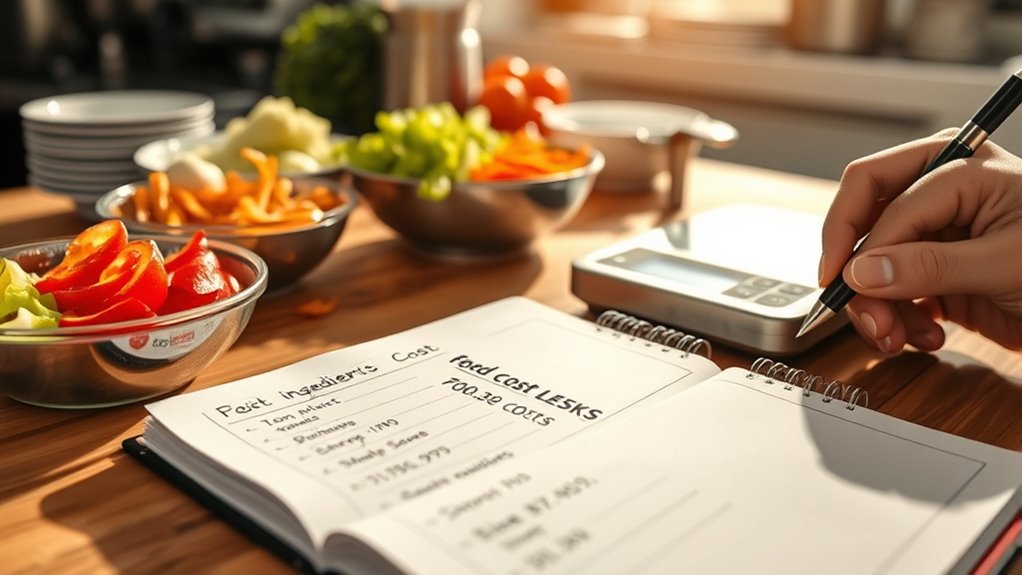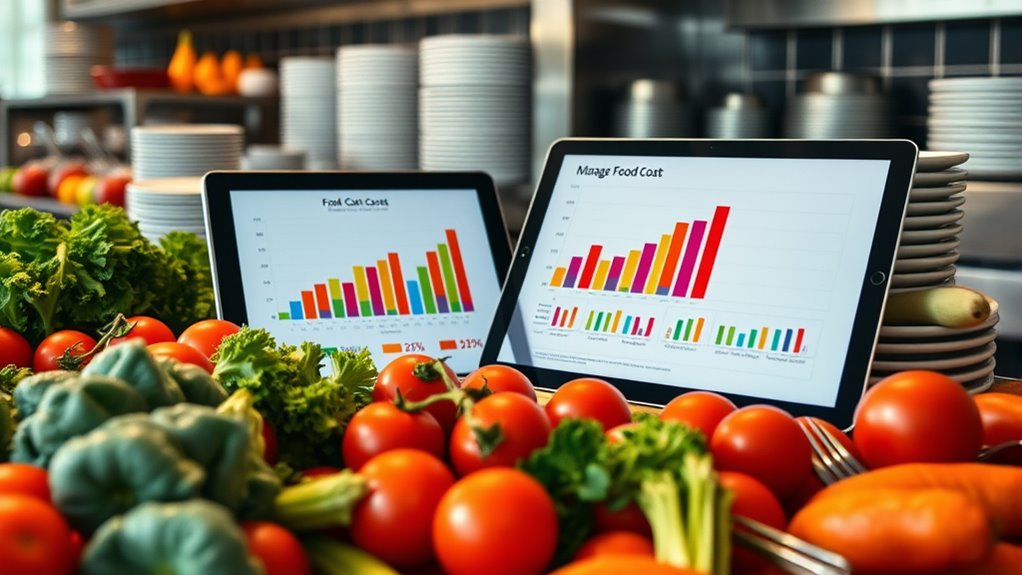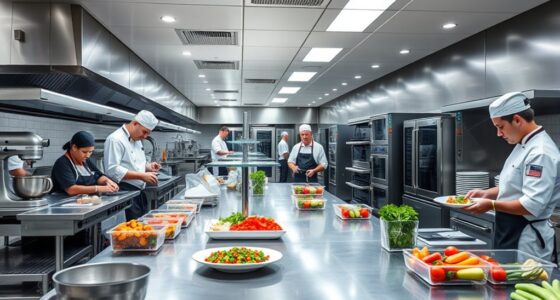Food cost percentage shows how much of your restaurant’s revenue is spent on food ingredients and supplies. It’s calculated by dividing your food costs by total sales and then multiplying by 100 to get a percentage. Usually, a good range is between 28% and 35%, depending on your restaurant style. Keeping an eye on this metric helps you control expenses and improve profit margins. To learn more about managing this critical figure, keep exploring.
Key Takeaways
- Food cost percentage is calculated by dividing food costs (COGS) by total sales, then multiplying by 100 to get a percentage.
- It indicates the portion of revenue spent on food expenses in a restaurant or food service business.
- Typical target ranges are between 28% and 35%, depending on the restaurant type.
- Monitoring this percentage helps control costs, guide pricing, and maintain profitability.
- Factors influencing it include menu pricing, inventory management, waste reduction, and market conditions.

Have you ever wondered how restaurants keep their profits steady despite fluctuating food prices? The secret lies in understanding and managing your food cost percentage. This metric is essential because it helps you control expenses and set effective menu pricing strategies. When you keep an eye on your food cost percentage, you guarantee your restaurant remains profitable, even when ingredient costs change unexpectedly.
At its core, food cost percentage is a simple calculation: you divide your cost of goods sold (COGS), which is primarily your food costs, by your total sales, then multiply by 100. For example, if you spent $3,000 on food in a month and your sales for that same period were $10,000, your food cost percentage is 30%. This figure tells you how much of your revenue is going toward food expenses. Most restaurants aim for a specific percentage, typically between 28% and 35%, depending on their style and overhead costs.
Managing this percentage effectively hinges on two main factors: menu pricing and inventory management. Setting the right menu prices isn’t just about covering costs; it’s about balancing profitability with customer expectations. If your prices are too low, your food cost percentage will spike, squeezing your profit margin. Conversely, pricing too high might turn away customers. By understanding your food cost percentage, you can adjust menu prices strategically to maintain a healthy margin without sacrificing competitiveness.
Inventory management plays an equally critical role. Keeping a tight grip on inventory helps prevent waste, theft, and spoilage—all of which can inflate your food costs unexpectedly. Regular inventory checks allow you to track what you’re using versus what you should have, giving you insights into usage patterns and potential issues. When you manage your inventory well, you avoid over-purchasing and reduce waste, directly impacting your food cost percentage. Accurate inventory management also enables you to identify expensive ingredients or portions that are too large, so you can make adjustments to keep costs in line. Additionally, implementing vertical storage solutions can optimize space and improve inventory accuracy.
Together, menu pricing and inventory management form a powerful duo to control your food cost percentage. By setting prices that reflect your actual costs and monitoring your inventory diligently, you can maintain a steady profit margin regardless of market fluctuations. This proactive approach allows you to adapt quickly, optimize your operations, and ensure your restaurant remains financially healthy. Ultimately, understanding and managing your food cost percentage isn’t just a number; it’s a critical tool that supports the long-term success of your business.
Frequently Asked Questions
How Often Should I Review My Food Cost Percentage?
You should review your food cost percentage weekly or biweekly to stay on top of inventory management and spot trends early. Regular reviews help you identify discrepancies, control waste, and optimize supplier negotiation strategies. Consistent monitoring guarantees your costs stay aligned with your pricing goals, enabling you to adjust orders or renegotiate supplier terms promptly, ultimately maintaining healthy profit margins and efficient operations.
What Tools Can Help Track Food Cost Percentage Accurately?
You can’t afford to guess when tracking food cost percentage—use powerful tools like inventory management systems and supplier negotiation apps that keep you laser-focused. These tools streamline inventory tracking, minimize waste, and optimize supplier deals, giving you real-time data and control. With them, you’ll spot cost leaks instantly, make smarter purchasing decisions, and keep your food costs under control like a true pro.
How Does Food Cost Percentage Impact Menu Pricing Strategies?
Food cost percentage directly influences your pricing strategies and profit margins. When your food costs rise, you need to adjust menu prices to maintain profitability without alienating customers. Conversely, a lower food cost percentage allows for more flexible pricing, boosting profit margins. By monitoring this percentage regularly, you guarantee your menu prices align with costs, helping you stay competitive and maximize profits while offering fair prices to your customers.
Can Food Cost Percentage Vary by Cuisine Type?
You might think food cost percentage stays the same across cuisines, but ingredient variance and supplier pricing can cause it to fluctuate. Different cuisines use diverse ingredients—some premium or seasonal—that impact costs. For example, seafood-heavy dishes may have higher percentages than vegetarian options. So, yes, your food cost percentage can vary by cuisine type, requiring tailored pricing strategies to maintain profitability and reflect ingredient costs accurately.
What Are Common Mistakes in Calculating Food Cost Percentage?
You often make mistakes in calculating food cost percentage by neglecting proper inventory management and portion control. Forgetting to account for inventory shrinkage or miscounting stock can skew your results. Overlooking portion sizes leads to inaccurate food cost calculations, affecting profitability. To avoid this, always track inventory carefully, enforce portion control, and double-check your data. These steps guarantee you get an accurate percentage, helping you make better financial decisions.
Conclusion
So, next time you’re calculating your food costs, remember that your food cost percentage isn’t just a number—it’s a reflection of your restaurant’s success. Coincidentally, paying close attention to this percentage can lead to unexpected profit boosts and better menu pricing. Keep an eye on it, and you might just find that small adjustments make a big difference. After all, sometimes the key to thriving is right in the numbers you least expect.









